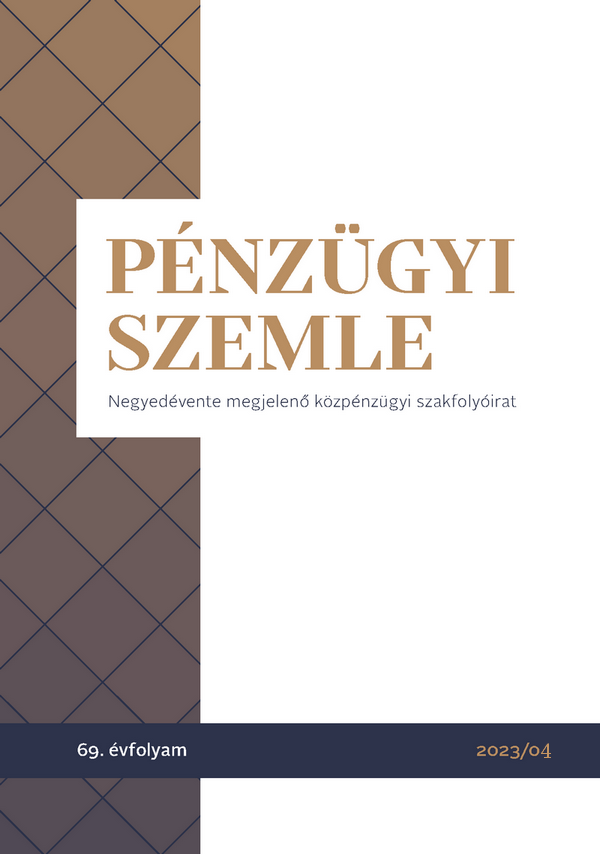Funding gap in the Hungarian venture capital market
DOI:
https://doi.org/10.35551/PFQ_2023_4_2Keywords:
financial intermediary system, risk capital, financing gap, state aid schemes, G24, D53, H25Abstract
Our study investigates the size of the so-called financing gap in the Hungarian venture capital market, i.e. the amount that can potentially be lent out, which is currently not covered by the Hungarian financial intermediary system on a market basis. The relevant literature will be reviewed to assess the performance and characteristics of the Hungarian market. The Hungarian financial intermediation system, traditionally based on banking, underperforms in all segments of capital market financing, even by Central and Eastern European standards. In our research, we sought to find out whether the available sources of venture capital could meet market needs. Both the number and volume of transactions in the domestic venture capital and private equity markets are low by international standards, and the role of the state is below the average for CEE countries. The novelty of our analysis lies in the fact that there is no similar literature available in Hungary. Our estimation based on linear regression revealed a strong relationship between venture capital investment and current GDP. The difference between the estimated potential risk capital stock and the annual averages zrealized clearly shows the market gap. In addition to the public programmes already implemented, the annual amount of risk capital missing from the domestic market is in the order of EUR 12.5-31.6 million, i.e. roughly HUF 5.1-13.3 billion per year at the euro exchange rate at the time of analysis. If this resource were available, domestic startups would have greater growth opportunities. Our analysis suggests that not only a state presence but even an increase in it, seems justifiable (or at least worth exploring). The research was supported by the National Research, Development and Innovation Office (FK-142492).
References
Allen, F., Gale, D. (1995). A welfare comparisons of intermediaries and finan-cial markets in Germany and US. European Economic Review, Vol. 39., No. 2., 179–209. oldal
Ács J. Z., Szerb L., Autio, E. és Lloyd, A. (2017). Global Entrepreneurship Index. The Global Entrepreneurship and Development Institute, Washington, D. C.
Becsky-Nagy P., Fazekas B. (2015). Befektetés vagy tanulópénz? Az uniós és állami források hatása a magyarországi kockázatitőke-piac fejlődésére. Pénzügyi Szemle, 60, 243–253. oldal
Becsky-Nagy P., Fazekas B. (2017). Résen van-e az állam? Az állami szerepvállalás hatása a kockázati tőke keresleti oldalára. Közgazdasági Szemle, 64, 507-527. oldal
Bethlendi A., Mérő K. (2020). A pénzügyi közvetítés struktúrájának változásai – a kelet-közép-európai régió speciális fejlődése a nemzetközi és európai folyama-tok tükrében. Külgazdaság, 64 (3-4). 45-72. oldal
Demirguc-Kunt, A., Levine, R. (1999). Bank-based and market-based financial systems – cross-country comparisons. Policy Research Working Paper Series 2143, The World Bank, Washington.
Fazekas B., Becsky-Nagy P. (2018). Az állam a kockázati tőkés szerepében. Köz-gazdasági Szemle, 65, 1257–1280. oldal
Harding, R. (2002): Plugging the knowledge gap: An international comparison of the role for policy in the venture capital market. Venture Capital, Vol. 4. No. 1. 59–76. oldal. https://doi.org/10.1080/13691060110093019
Karsai J. (2006). Kockázati tőke európai szemmel. A kockázati- és magántőkeipar másfél évtizedes fejlődése Magyarországon és Kelet-Közép-Európában. Közgazdasági Szemle, 53, 1023–1051. oldal
Karsai J. (2022). A kelet-közép-európai startupok romló kilátásai a nemzetközi kockázatitőke-piacon. Közgazdasági Szemle, 69, 1009-1030. oldal
King, R.G., Levine, R. (1993). Finance, entrepreneurship and growth: Theory and evidence. Journal of Monetary Economics, 32(3), 513-542. oldal
Mérő K., Bethlendi A. (2022). Financial Markets: Banks and Capital Markets. In: Mátyás, L. (eds) Emerging European Economies after the Pandemic. Contributions to Economics. Springer, Cham. https://doi.org/10.1007/978-3-030-93963-2_2
Mérő K. (2003). A gazdasági növekedés és a pénzügyi közvetítés mélysége. Közgazdasági Szemle, 50, 590-607. oldal
Nagy P. (2004). Az informális és a formalizált kockázati tőke szerepe a finanszírozási rések feloldásában. VIII . Ipar- és vállalatgazdasági konferencia, Pécsi Tudományegyetem, október 21–22.
Szerb L. (2006). Az informális tőkebefektetés és a kockázati tőke szerepe a vállalatok finanszírozásában. IN Makra Zs. (szerk.) [2022]. A kockázati tőke világa. Aula Kiadó, Budapest, 95–122. oldal
Szüle B. (2019) Rendszerkockázati dimenziók a magyar banki és biztosítási szektorban. Pénzügyi Szemle, 64 (2), 265-280. oldal.
Tóth R., Kása, R. és Lentner, Cs. (2022). The Impact of Financial Culture on the Operation of Hungarian SMEs before and during COVID-19. RISKS 10(7), 135. https://doi.org/10.3390/risks10070135
Vörös M. (2012) Állami támogatás a magyar kkv-szektorban: miből mennyi jut? Pénzügyi Szemle. Online: https://www.penzugyiszemle.hu/vitaforum/allami-tamogatas-a-magyar-kkv-szektorban-mibol-mennyi-jut
BIS (2022). Data Portal. Online: https://www.bis.doc.gov/index.php/da-ta-portal
Deloitte (2017). Tematikus célkitűzéseken átívelő témakörök Ex-ante elemzé-sek felülvizsgálata – MFB. Online: https://www.palyazat.gov.hu/download.php?objectId=76195
ECB (2022). ECB Statistical Data Warehouse. Online: https://sdw.ecb.europa.eu/
Eurostat (2022). Eurostat Data Browser. Online: https://ec.europa.eu/euros-tat/databrowser/explore/all/all_themes
IMF (2022). IMF Financial Development Index Database. Online: htt-ps://data.imf.org/?sk=f8032e80-b36c-43b1-ac26-493c5b1cd-33b&sId=1481126573525
Invest Europe (2022a). Investing in Europe: Private Equity Activity 2021. Online: https://www.investeurope.eu/media/5184/invest-europe-activity-da-ta-report-2021.pdf
Invest Europe (2022b). Central and Eastern Europe Statistics 2021. Online: https://www.investeurope.eu/media/5283/cee-2021-activity-statis-tics-report.pdf
MKME (2022). Magyar Kockázati- és Magántőke Egyesület: Investment Moni-toring Riport FY2021. Online: https://www.hvca.hu/documents/HVCA_re-port_2021_final.pdf
MNB (2022). MNB Statisztikai adatok, idősorok: A nemzetgazdaság éves pénzügyi számlái, Pénzügyi eszközök és kötelezettségek állománya, Nem pénzügyi vállalatok. Online: https://statisztika.mnb.hu/idosor-1241
OECD (2022). Financing SMEs and Entrepreneurs 2022. Online: https://www.oecd-ilibrary.org/industry-and-services/financing-smes-and-entrepre-neurs-2022_e9073a0f-en
Világbank (2022). World Bank Database: Market capitalization of listed domes-tic companies (% of GDP) – OECD Members. Online: https://data.worldbank.org/indicator/CM.MKT.LCAP.GD.ZS?locations=OE
Downloads
Published
How to Cite
Issue
Section
License
Authors assign copyright to Pénzügyi Szemle / Public Finance Quarterly. Authors are responsible for permission to reproduce copyright material from other sources.












